Above: Seated before the shah, the Persian advisor Buzurgmihr (to right of chessboard) demonstrates his mastery of the game to a downcast challenger, an envoy from the court of India. The match was recorded in the Shahnamah (Book of Kings) by the 11th-century Persian poet Abu’l-Qasim Firdawsi, and this illustration appeared in a 14th-century edition.
Below: “A Board Game” is an illustration from a 16th-century Firdawsi Shahnamah. |
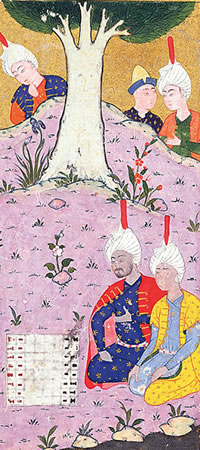 |
| ABOVE: british library / bridgeman art library (detail) |
 Diego Lopez, commander of the first Portuguese expedition to Malacca, in the East Indies, was playing chess when a Javan from the mainland came aboard. The Javan immediately recognized the game and the two men discussed the form of the pieces used in the chess played there. They no doubt communicated through interpreters, but the fact that men whose homes were separated by a third of the circumference of the Earth could find they had chess in common is remarkable—and so is the fact that they could have found other players familiar with the game at any stopping point in Asia, the Middle East or Europe.
Diego Lopez, commander of the first Portuguese expedition to Malacca, in the East Indies, was playing chess when a Javan from the mainland came aboard. The Javan immediately recognized the game and the two men discussed the form of the pieces used in the chess played there. They no doubt communicated through interpreters, but the fact that men whose homes were separated by a third of the circumference of the Earth could find they had chess in common is remarkable—and so is the fact that they could have found other players familiar with the game at any stopping point in Asia, the Middle East or Europe.
What was this game that crossed boundaries of language, religion, culture, geography, ethnicity and class, and was woven deeply into the fabric of the greater Asian and wider world? The rules and moves of the various chess pieces are, after all, so simple that any schoolchild can learn them.
The youngster also quickly learns that simply knowing how a knight or a queen moves does not lead to winning. Rather, the game involves escapes, feints and sacrifices. There is a give and take of possibilities, and scope for creativity and unexpected, brilliant moves. Every move results in a different pattern of possibilities for the next moves, and the patterns signal advantage, challenge or danger. There is no recovery by chance—no helpful roll of the dice or spin of the wheel, no lucky draw of the cards.
In essence, chess is warfare, as much psychology as strategy. To win, one must understand the mentality of the opponent, hinted at in each new move. One must so thoroughly master the adversary’s weaknesses—an overzealous offence? guarding rather than attacking? a passion for sweeping one end?—that one can anticipate them and use them. Chess is a game of information, false and true, derived from what the opponent “should” do, based on his own past play or that of others, and on what the opponent actually does. Chess has no bloodshed, but the exhilaration of psychological warfare—taking no prisoners in a complete victory—is its attraction.
Archeological evidence suggests that chess has ancient roots in Persia and Central Asia. Excavations at the seventh-century site of Afrasiab, the oldest part of today’s Samarkand, Uzbekistan, have turned up seven small, carved figures that closely resemble later Persian descriptions of chess pieces, including a king, fazin (“counselor”), elephant, horse, chariot and pawn. The earliest literary reference to chess is in a Persian romance of the same period, about 600, the Karnamak-i Artaxshir-i Papakan (Deeds of Ardashir, Son of Papag). Along with excelling in the courtly pursuits of hunting and riding, the hero was also a skilled chess player.
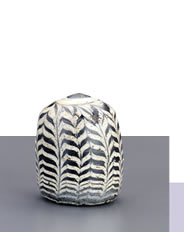 |
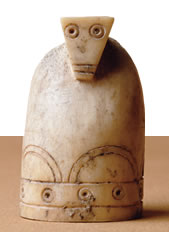 |
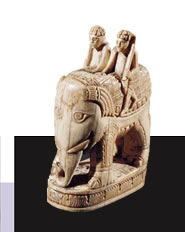 |
| left: freer gallery, smithsonian institution / bridgeman art library; center: réunion des musées nationaux / art resource; right: erich lessing / bibliotheque nationale, paris / art resource (detail) |
| Left to right: A chess piece of marbled glass dates from Fatimid Egypt and was made between the 10th and 12th centuries. An ivory pawn from a ninth- or 10th-century Arab set. An elephant from 12th-century Italy recalls the game’s Indian origins. |
Chess, however, was not invented in Persia. All early Persian references to chess use the term chatrang, from the Sanskrit chaturanga (“in four parts”), which describes the four components of an early Indian army: infantry, cavalry, elephants and chariots. The use of a Sanskrit-derived word for chess in an early Persian romance suggests an Indian origin for the game and not local invention, although supporting evidence is murky. Early Sanskrit literature mostly refers not to chess, but to board games that used dice. Most are long forgotten, though at least one—the chase game of pachisi, trademarked as Parcheesi—is still played.
The only convincing early Indian mention of chess is in a romance attributed to the sixth century, thus slightly earlier than the first Persian and Central Asian evidence. The poet Subandhu used a chess image to describe the monsoon season:
The time of the rains played its game with frogs for chessmen which, yellow and green in color … leapt up on the black field squares.
A story of the seventh-century Persian king Nushirvan (recorded by Firdawsi in the 11th-century Shahnamah, or Book of Kings) also supports an Indian origin of chess. An envoy came from India, the story says, “with elephants, parasols, and cavalry” and a chessboard, chessmen and a challenge: If Nushirvan’s courtiers could figure out the basic rules of the game, then unknown in Persia, the Indian king would gladly pay tribute to the Persian monarch. If they failed, however, Nushirvan would pay tribute to the Indian king. Nobles and priests labored without success for a week. Finally, after a day and a night of struggle, Nushirvan’s vizier deciphered and described the game:
The sage has invented a battlefield, in the midst of which the king takes up his station. To the left and right of him the army is disposed, the foot-soldiers occupying the rank in front. At the king’s side stands his sagacious counselor, advising him on the strategy to be carried out during the battle. In the two directions the elephants are posted with their faces turned toward the conflict. Beyond them are stationed the war-horses, on which are mounted two resourceful riders, and fighting alongside them to the left and right are turrets ready for the fray.
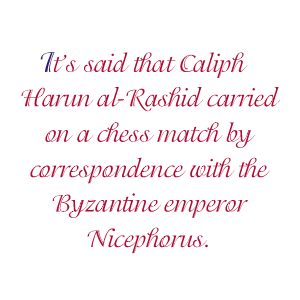 Arab writers on chess acknowledge that the game spread west from Persia, probably soon after the Islamic conquest in the mid-seventh century. The Arabic term for the game was and is shatranj, a standard linguistic shift from the Persian chatrang, and all the names of the chess pieces (with the exception of the horse) are Arabic versions of their Persian names. As it spread, however, the game did not always find itself welcome. The Eastern Church at Constantinople condemned chess as a form a gambling in 680, and al-Hakim, the Fatimid ruler of Egypt, banned it in 1005 and ordered all chess sets burned.
Arab writers on chess acknowledge that the game spread west from Persia, probably soon after the Islamic conquest in the mid-seventh century. The Arabic term for the game was and is shatranj, a standard linguistic shift from the Persian chatrang, and all the names of the chess pieces (with the exception of the horse) are Arabic versions of their Persian names. As it spread, however, the game did not always find itself welcome. The Eastern Church at Constantinople condemned chess as a form a gambling in 680, and al-Hakim, the Fatimid ruler of Egypt, banned it in 1005 and ordered all chess sets burned.
The eastward movement of chess, into China and Southeast Asia, has even less documentation than its movement west. The initial reference to chess in China comes in the Yu Kuai Lu (Book of Marvels) dating to about ad 800. It recounts the story, set in 762, of a man “who dreamt of a battle in which the moves of the forces: horses, commanders, waggons and armoured men, resembled those in Chinese chess,” writes Richard Eales in Chess: The History of a Game. “He awoke to find a set of chessmen buried in a nearby well.”
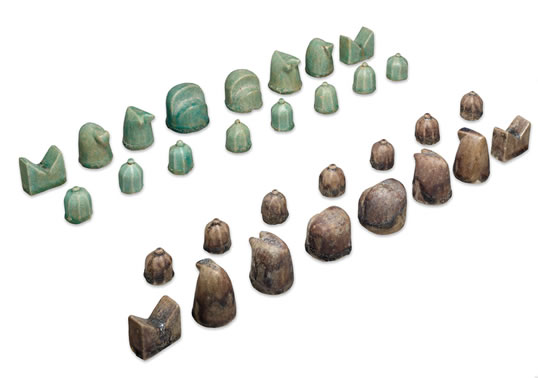 |
| METROPOLITAN MUSEUM OF ART |
| Although the arrangement of these pieces would be familiar to a modern player, their names, and the moves each is allowed to make, have had many variations since this ceramic set from 12th-century Nishapur, Iraq was last played. The kings measure 55 millimeters high. |
Regardless of that tale’s veracity, there is overwhelming evidence for strong trade and cultural ties between India and China, along the Silk Roads and the southern maritime routes through Southeast Asia. This is, after all, the period of the Tang Dynasty, during which foreign ideas, costumes and food were officially welcomed at court. There were more than 200 trade or religious missions between India and China between about 650 and 850. Sugarcane and the technology to make it a cash crop moved from India to China, and papermaking know-how moved along the Silk Roads to the Middle East. Commercial mango cultivation migrated from India to Java. It would be surprising if a game as intriguing as chess, already played in India and Central Asia for a century or more, had not also moved along the caravan routes to China or the sea routes to Southeast Asia. From this early period until today, chess has been popular in Malaysia, Burma, China and portions of the Southeast Asian archipelago.
After about 700, chess spread rapidly from court to court and city to city within a broad swath of territory running from Egypt through the rest of North Africa to Spain. H. J. R. Murray’s magisterial A History of Chess, first published in 1913, brought together many of the early references to chess and chess play. For example, Said bin al-Musayyib (died 710) of Madinah played in public and declared chess permissible provided there was no gambling on the outcome. Muhammad bin Sirin (died 728) was one of the first chess masters to play blindfolded. Three granddaughters of another blindfold player, Hisham bin Urwa (died 765), were all chess players. Chess allusions appeared in poetry: Al-Faradaq (died about 728) wrote, “I keep you from your inheritance and from the royal crown so that, hindered by my arm, you remain a pawn among pawns.” Such an allusion worked only if the courtly audience knew that a pawn, by advancing to the farthest row on the board, could be converted to a more powerful piece.
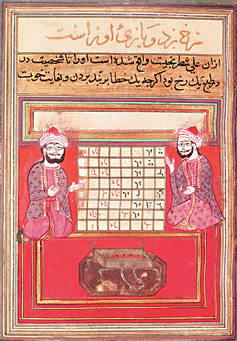 |
| royal asiati c society / bridgeman art library |
| This illustration from a Persian treatise on chess, possibly dating from the 14th century, is notable for its expressive faces that hint at the “different kinds of pleasantry and jests” Mas‘udi recorded as customary among players at that time in Baghdad. |
Baghdad, founded in 750 as the Abbasid dynastic capital, soon ranked with Delhi, Beijing and Constantinople among the largest, wealthiest and most sophisticated cities in the world. Its bazaars, libraries and banquets were the stuff of legend in Europe. The caliph and his nobles supported all manner of learning and innovation, including the translation of Greek texts on science, mathematics, geography, astronomy, agriculture and medicine. Religious commentary flourished. The caliphs regularly brought the most learned men in the Middle East, Central Asia, Egypt and India to Baghdad—and chess was part of this intellectual flowering. Chess masters from Persia and Central Asia came to the court to find patronage and to challenge the best players in the Islamic world.
Several early caliphs were avid players themselves. It’s said that the caliph Harun al-Rashid carried on a chess match by correspondence with the Byzantine emperor Nicephorus around 800, but that the two parted ways—and even waged real war—after the emperor accused Harun of making his predecessor a pawn to the caliph’s rook. Harun’s successor, his son al-Amin (died 813), figures in an apocryphal chess tale: At a critical point in the siege of Baghdad by forces loyal to his half-brother al-Ma‘mun, al-Amin received a message during a game of chess. Baghdad’s capture was imminent, the messenger said, advising him that this was not the time to play chess, but to look to the city’s defenses. Al-Amin told the messenger to be patient; he was only a few moves from checkmating his opponent. It is not known how the chess game ended, but al-Amin was captured and paid for his concentration with his life.
The names and some of the writings of the handful of chess masters (aliyat) of the Abbasid court have come down to us. The first was al-Adli, who received all challengers and dominated chess at court in the 850’s. He was defeated by a player named al-Razi, a generation younger, who dominated chess at court for several decades.
The two most famous Abbasid chess masters, al-Lajlaj and al-Suli, appeared in the 10th century. Both are known from extensive extracts of their writings in two manuscripts of a book entitled Book of Chess: Extracts From the Works of al-Adli, as-Suli and Others, compiled in the mid-12th century. These early books often included opening sets of moves—with such names as Pharaoh’s Stone, the Torrent, the Slave’s Banner—and standard, but often maddeningly difficult, “problems.” Typically, a problem set out an array of pieces on the board and challenged the reader to win in a set number of moves. Over the following few centuries, a set of 77 problems became standard for anyone studying chess. These were known as mansubat. One problem, by al-Suli, remained unsolved for more than a thousand years.
At the Baghdad court, chess was not the sober, largely silent affair that it is today. Players were expected to maintain a witty, erudite banter with each other and with spectators. “Chess players employ different kinds of pleasantry and jests designed to astound,” wrote the great 14th-century historian al-Mas‘udi. “Many maintain that these incite people to play, and add to the flow of resource and accurate deliberation…. They are just as much part of the apparatus of the player as the song and improvised verse of the warrior.” Many verses describing this custom have been composed:
Hotter than the glow of charcoal glows the player’s timely jest.
Think how many a weaker player it has helped against the best.
Court poets continued to develop chess imagery. Several noticed that the Persian word for the “castle” piece (rukh) was the same as the Arabic word for “cheek” and played on its double meaning. Even a few common jibes using chess imagery have been preserved: Around the court, for example, a short man was referred to as a “pawn.”

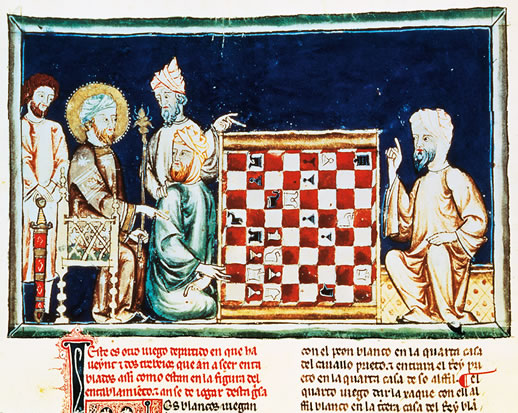 |
| biblioteca monasterio del escorial / Index / bridgeman art library |
| On this page from the 1282 Libro de los Juegos (Book of Games), or Libro de acedrex, dados e tablas (Book of Chess, Dice and Boards), Alfonso X discusses a chess problem with two turbaned players. |
 lfonso X (1221–1284), king of Castile, Léon and Galicia, was the greatest Christian patron of translations of Arabic learning in the Middle Ages. The son of Ferdinand III of Castile and Elisabeth of Hohenstaufen, he laid claim to the title of Holy Roman Emperor.
lfonso X (1221–1284), king of Castile, Léon and Galicia, was the greatest Christian patron of translations of Arabic learning in the Middle Ages. The son of Ferdinand III of Castile and Elisabeth of Hohenstaufen, he laid claim to the title of Holy Roman Emperor.
Even as a young man, he showed great interest in scholarship and surrounded himself with Christians, Jews and Muslims who could carry out the translations he required—most of them into Castilian rather than the Latin more common in court use. He came to be known as el Sabio (“the Learned”). Few of his translations survive intact, but we know that Alfonso was interested in the sciences, magic, alchemy, astronomy, guides to governance and law. He also wrote several works of poetry and prose, both much influenced by Arabic sources and styles.
His Book of Games is an extraordinary document, covering both chess and a variety of other board games of the 13th century. The manuscript, consisting of 98 lavishly illustrated vellum pages, is in the Escorial Library near Madrid, having arrived there sometime in the 16th century. It consists of an introduction, a series of chess problems and discussion of other board games. The original language was Castilian; scholars have produced a German translation, but, as yet, there is no published version in English. However, John G. White, patron of the chess collection at the Cleveland Public Library, commissioned an English translation from one “R.A.A.” of St. Louis in 1927 that exists in typescript. The translator complained to White that it was not the Spanish of today but of “an epoch long since vanished,” with words archaic and obsolete, further grousing that “the grammar is often faulty, the punctuation miserable and confusing.”
Internal evidence from the Book of Games suggests that chess in 13th-century Spain was in transition from the game played in the Middle East and North Africa to what it would become in Europe. The rook seems to have shifted to a chariot form, perhaps because of the word roca, already in use in Spanish for “chariot.” The bishop was still called el alfil, from the Persian fil for “elephant.” Flanking the king was el alferaza (from the Persian al-farzin, “counselor”), not yet the queen of later European play. The pieces were expected to be more representative than Islamic custom allowed: The king, for example, is described as “seated on a throne.” The move known as “castling” had not yet been invented. The illustrations of the Book of Games are similarly mixed, some showing various sorts of Muslim players, identifiable by their dress; others set in various medieval European courtly contexts; and yet others showing play between Muslims and Christians, as well as by Jews, women and tradesmen. Throughout, the boards are checkered, a usage not always found in Arabic play at the time.
Because the currently available edition of the manuscript (in Spanish) is quite costly, the best place to see additional illustrations and problems from the Book of Games is the Web site of a current-day chess enthusiast: http://games.rengeekcentral.com.

 he White Collection in the Cleveland Public Library is the largest library in the world dedicated to chess. Its holdings include more than 35,000 books—more than 50 printed before 1500—several thousand periodicals, about 2000 newspaper columns, manuscripts on the history of chess, chess manuals, records of games and competitions, and biographies of players. The collection has material on every peripheral aspect of chess, including literary, philosophical, religious, historical and scientific works that refer to chess.
he White Collection in the Cleveland Public Library is the largest library in the world dedicated to chess. Its holdings include more than 35,000 books—more than 50 printed before 1500—several thousand periodicals, about 2000 newspaper columns, manuscripts on the history of chess, chess manuals, records of games and competitions, and biographies of players. The collection has material on every peripheral aspect of chess, including literary, philosophical, religious, historical and scientific works that refer to chess.
Printed materials include rare editions and annotated copies of books from the libraries of chess players or collectors. Manuscripts include originals and translations of works in Persian, Sanskrit, Arabic, Latin and several Slavic languages. The library holds more than 2000 chess pieces from various historical periods and locations.
White was a wealthy collector who was deeply involved in the development of the Cleveland Public Library system. He was a patron of Harold Murray, whose A History of Chess (1913) is still the most comprehensive history of the game. At his death in 1928, White donated his entire collection to the Cleveland Public Library and gave the remainder of his estate as an endowment to build a luxurious research room and maintain and expand the collection in perpetuity.
Other large and important public collections on chess are in the Royal Library at The Hague in the Netherlands; the M. V. Anderson Collection at the State Library of Victoria in Australia; the Cook and Spackmann collections at Princeton University; and the Willing Collection at the Free Library in Philadelphia.
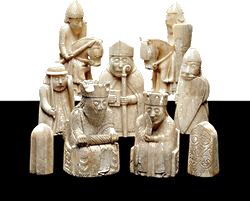 |
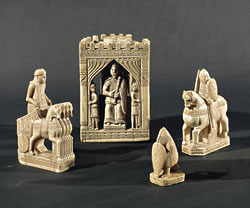 |
| top: british museum / art resource; lower: erich lessing / bibliotheque nationale, paris / art resource (detail) |
Top: One of the few complete early European chess sets is that known as the “Lewis Chessmen,” probably made in Trondheim, Norway between 1150 and 1200 from walrus ivory and whales’ teeth. It was in Europe that the figure of the queen was introduced into the game.
Above: Ivory pieces from 12th-century southern Italy show the rook as a charioteer in a quadriga, the knight as a mounted warrior in chain mail, the king in his castle and the pawn as a foot-soldier with his shield. |
In the 10th and 11th centuries, chess spread northward to Russia and Scandinavia from the Middle East with the Norse Volga River trade. The oldest extent chess set in Europe, unearthed by archeologists, is from Scandinavia. Slightly later, chess moved into Italy, at that time a scene of much contact and conflict among Muslims, Byzantines and Norman invaders. Several striking chess pieces dating to the 11th century have turned up in Italy and Germany’s Rhine Valley.
As chess settled into new locales, the overall rules remained much the same, but the shapes of the pieces varied. Among nomads of Central Asia, for example, the camel sometimes replaced the elephant. Among Tibetans, the lion replaced the king and the tiger replaced the vizier, although the moves of each were the same as in the old Indian game. In Europe, the queen replaced the vizier in one of several shifts to more mobile and powerful pieces that sped up the game. At about the same time, the bishop replaced the elephant and acquired its characteristic diagonal move. (It has been suggested that the shape of the Middle Eastern elephant piece, with high curved points, suggested a bishop’s miter to European players.)
In the Middle Ages in Europe, chess was played more widely than at any time before or since. Among the upper classes, the game was a kind of mania; any cultured man or woman was expected to know the rules. Kings and nobles played in their gardens, tradesmen in their businesses. Women played each other and played men. Monks and prelates of the church played. Chess entered the artwork of the period in mosaic floors, stained-glass windows and illuminated manuscripts. Nothing illustrates the variety of settings and players better than the remarkable Alfonso X manuscript of 1283, The Book of Games, whose illustrations each show a board with two players in settings where they might work out the problem posed.
By the early 15th century, chess was everywhere in Europe and Asia. In Russia, it flourished in spite of religious and civil condemnations as “Hellenic devilry.” In Central Asia, the great 14th-century empire-builder Timur (Tamerlane) was an avid player. A century later, Babur, a descendent of Timur, conquered northern India and founded the Mughal Empire. Many of his nobles were avid chess players, and in his memoirs, Babur characterized one of his nobles as “so madly fond of chess that that if he met two players, he would hold one by the skirt while he finished his game with the other, as if to say, ‘Don’t go!’” In his new capital city of Fatehpur Sikri, Babur’s grandson Akbar built a life-sized chessboard in a courtyard and—using dancing girls and courtiers as pieces—played from the apartments above.
The Persian term, shah, for the king chess piece drifted into various languages as the name of the game itself: the Italian scacchi, the Dutch schaakspiel, the German Schachspiel, the Serbian shkak, the Icelandic skaktafl and the Old French éches, from which comes the English chess. Chess showed up in letters, poems, government documents and books; chess sets appeared in wills.
In our time, the true heritage of a game that has always transcended boundaries is visible on the Internet. At any hour of the day or night, one can play against hundreds of waiting opponents, none of whom will know their rival’s name, religion, age, gender, occupation or location on the globe. Nevertheless, the thrill of the battle, the struggle to understand the opponent’s psychology, to penetrate the feints and ruses, remains as vibrant and satisfying as it was when traders and soldiers first carried the game far and wide from its birthplace in India or South Asia some 14 centuries ago.
 |
Stewart Gordon is a senior research scholar at the University of Michigan’s Center for South Asian Studies. His 2008 book, When Asia Was the World (Da Capo), looked at family, trade and intellectual networks across Asia between ad 500 and 1500. His forthcoming book, Routes (University of California Press), considers societies and travelers along the great trade routes. |





